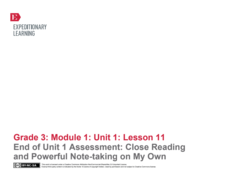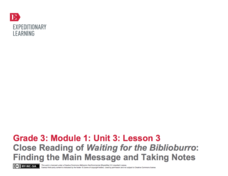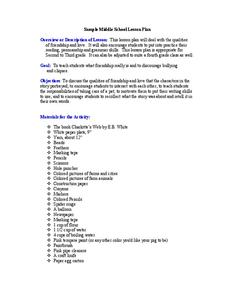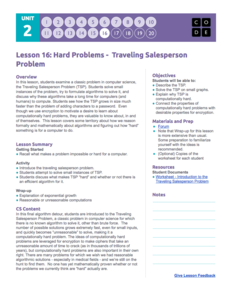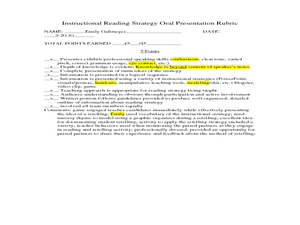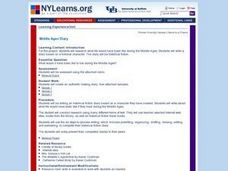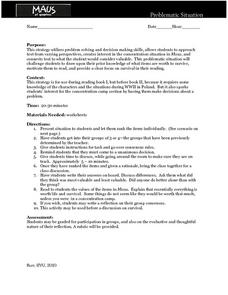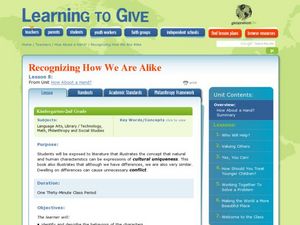EngageNY
End of Unit 1 Assessment: Close Reading and Powerful Note-Taking on My Own
As the final lesson plan in a larger beginning-of-the-year unit to establish routines and teach close reading skills, this plan is designed as an assessment piece. Using the story, The Librarian of Basra, learners independently...
EngageNY
Close Reading of Waiting for the Biblioburro: Finding the Main Message and Taking Notes
Expose your class to Waiting for the Biblioburro, narrative nonfiction that will act as the bridge between ficiton and informational texts to come. Class members do a close reading of the text, looking at excerpts instead of the whole...
Quia
Charlotte’s Web Lesson Plan
Make your classroom into a place of kindness and compassion with E.B White's Charlotte's Web. The first four pages of the lesson plan guide you through several steps and projects, including discussions on Charlotte and Wilbur's...
Novelinks
The Hobbit: Problematic Situation
As part of a unit study of The Hobbit, class members engage in an activity that asks group to practice the skills needed to reach consensus in a discussion.
Curated OER
Amos and Boris: Text Study
Twenty insightful questions follow a read aloud of the story, Amos and Boris by William Steig. Scholars then show what they know through completion of a cause and effect chart, reading fluency assessment, and a written...
Code.org
Hard Problems – Traveling Salesperson Problem
Even computers find this to be a hard problem. In the eighth installment of a 12-part unit, young computer scientists learn about the traveling salesperson problem. They formulate algorithms to solve the problem and find out why it is...
National Endowment for the Humanities
Hamlet and the Elizabethan Revenge Ethic in Text and Film
Young scholars research the social context of Elizabethan England for Shakespeare's "Hamlet". They identify cultural influences on the play focusing on the theme of revenge and then analyze and compare film interpretations of the play.
Curated OER
Retelling
Explore language arts by completing a story worksheet in class. Readers will identify the importance of plot, setting, and character while they write their own short story. They also retell their story to a classmate and participate in a...
Curated OER
Historical Agency in History Book Sets (HBS)
Study historical events by combining the study of historical fiction and non-fiction. Learners read about true past events in historical fiction novels and then research non-fiction accounts of the same events. What are some differences...
For the Teachers
Sequence Plot Chart
Your kids can identify the plot sequence of a short story, but what about an informational article? Have them examine the chronological order of events in informational texts with a activity on the sequence of events.
For the Teachers
Story Strips Sequencing
What happens next? Work on story sequence with a lesson that prompts kids to put a story back in order. Additionally, they discuss what would happen if one event was missing from the sequence.
Curated OER
Romeo and Juliet
Students read Romeo and Juliet and then write an essay from the point of either Lord Capulet or Friar Lawrence persuading someone to adopt their views concerning marriage.
Curated OER
Creative Autobiography
Students brainstorm and outline ideas for their autobiography. They begin composition of it as well. Students create a timeline of important events to help them get started and discuss the elements of a what makes a good story.
Curated OER
Where the Red Ferns
Where the Red Fern Grows provides the text for a study of the literary elements of plot, character, and setting. Discussion questions and vocabulary lists are referenced but not included.
Curated OER
People Who Make A Difference: American Heroes
Students think about the characteristics of a hero so they can later evaluate which historical figures on the heroes chart meet the criteria.
Curated OER
Author's Purpose
Sixth graders brainstorm the reasons authors write, and they list their responses on the board. Students discuss each purpose they have listed.Students work independently to read the selection "Tarantulas and Typhoid" by...
Curated OER
Middle Ages Diary
Students research life in the Middle Ages. They write a historical fiction diary based on a character they create. Students use the six steps to process writing to complete their diary. They orally present their diaries to the class.
Curated OER
Comprehending Through Questioning
Elementary schoolers observe and apply a variety of reading comprehension strategies. They silently read a passage out of their science textbook, and discuss answering the who, what, where, when, and how of the text. In small groups they...
Curated OER
Characteristics of Anne Frank
Eighth graders read selected passages from The Diary of Anne Frank. Working in pairs, 8th graders determine what qualities and characteristics they would assign to her from their selected diary entry.
Curated OER
Comparing Two Poe Classics
Students read and discuss The Black Cat and The Tell-Tale Heart. In this poetry lesson, students construct a Venn diagram to compare and contrast two pieces of literature.
Curated OER
Alphabet
Primary learners will make posters, trace letters, and eat letter cereal, all to learn about the alphabet. They will also go on a scavenger hunt around the room looking for letters. This resources has lots of ideas for bringing about...
Curated OER
Maus: Problematic Situation Strategy
Do people really need “a newer, bigger Holocaust” in order to change? Or is it possible that by making text-to-self connections to the stories of others people that they can change? In order to connect to Art Spiegelman’s Maus, class...
Alabama Learning Exchange
Interactive Reading Project
Young scholars discuss books they are reading during the semester through e-mail with other students. They complete a reading interest survey, e-mail their partner weekly, and read and suggest six novels by the end of the semester.
Curated OER
Recognizing How We Are Alike
Students explore the concept of social justice. In this service learning worksheet, students read The Sneeches in order to appreciate cultural uniqueness.
